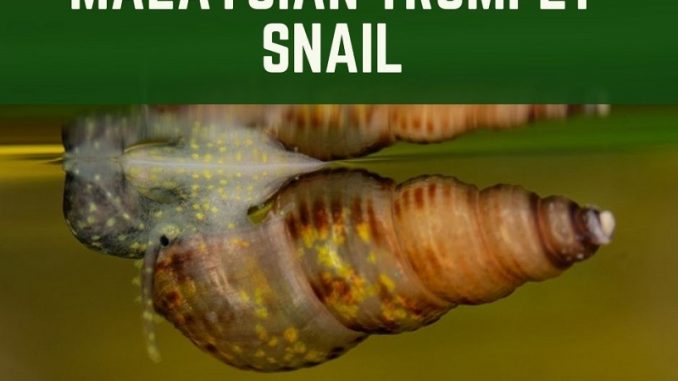
Pet or Pest? This is the question that aquarists debate over when discussing Malaysian Trumpet Snails.
These divisive snails provide benefits for an aquarium, but also come with drawbacks.
If you know what you’re doing, you can mitigate the drawbacks and successfully keep them in a species or community tank.
They are very hardy, so even beginners will be able to care for them without any problems.
This guide covers everything you need to know about Malaysian Trumpet Snails. This includes how to care for your pets, or how to remove pesky pests.
TABLE OF CONTENTS
Malaysian Trumpet Snail Facts & Overview
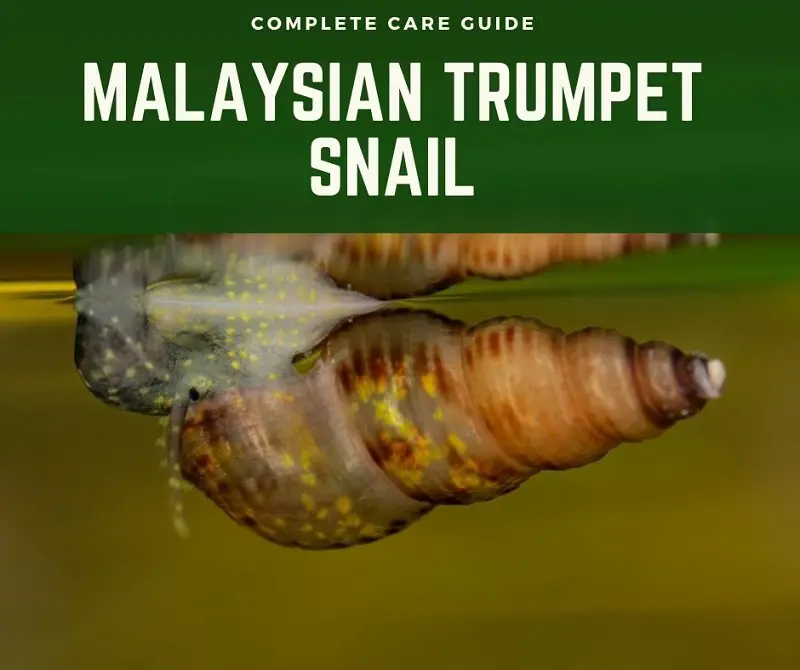
| Category | Rating |
| Care Level: | Easy |
| Temperament: | Peaceful |
| Color Form: | Brown or grey |
| Lifespan: | 2 years |
| Size: | Up to an inch |
| Diet: | Omnivore |
| Family: | Thiaridae |
| Minimum Tank Size: | 5 gallons |
| Tank Set-Up: | Freshwater with live plants |
| Compatibility: | Peaceful community |
Malaysian Trumpet Snails are referenced under a few different names, such as Malaysian Burrowing Snails, Malaysian Live Bearing Snails, and Red-Rimmed Melania.
Their scientific name is Melanoides tuberculata and they are part of the Thiaridae family. This family is often referred to as the Trumpet Snails.
Malaysian Trumpet Snails are native to Northern and Southern Africa, but they have been accidentally introduced to tropical regions around the world.
They make a successful invasive species, which is why they have managed to spread so easily. This ability has helped them to become pests in aquaria too.
Some people love these snails and choose to keep them as pets. Others hate them and try to keep them out of their aquarium at all costs.
They often enter a fish tank in secret, having been transported from a pet store along with living plants or livestock that have been purchased.
Their eggs are very hard to spot, so they go unnoticed.
This species is very common, they can be found in most pet stores and are sold very cheaply.
When purchasing some, choose individuals that are moving around or attached to hard surfaces. Those laying motionless or upside-down may be dead.
Look out for signs of disease in their tank mates too. If you spot that something is wrong, shop elsewhere.
A healthy snail should live for around 2 years, but if kept in their preferred environment this could stretch even longer.
Typical Behavior
This species is very peaceful and poses no threat to any of its tank mates. This makes them great for a community aquarium, as long as they aren’t living with any snail-eating creatures.
Malaysian Trumpet Snails are very slow-moving (like all snails) and won’t be able to escape if anything tries to eat them. Their only defense is to hide in their shell and seal themselves off with an operculum.
Most of their time is spent traversing a tank in search of food. They’ll vacuum up any uneaten food or detritus sat on the substrate and attach to hard surfaces to graze algae.
This helps to prevent algae from blooming and getting out of control.
These snails usually hide during the day by burrowing into the substrate with their mouth. They’ll re-emerge when the light levels drop to resume scavenging.
Moving the substrate like this helps to prevent harmful gas from building up and polluting the water.
One behavior you should be particularly aware of is their reproduction. They can breed rapidly, so populations can get out of control. This is why many aquarists view them as pests.
Appearance
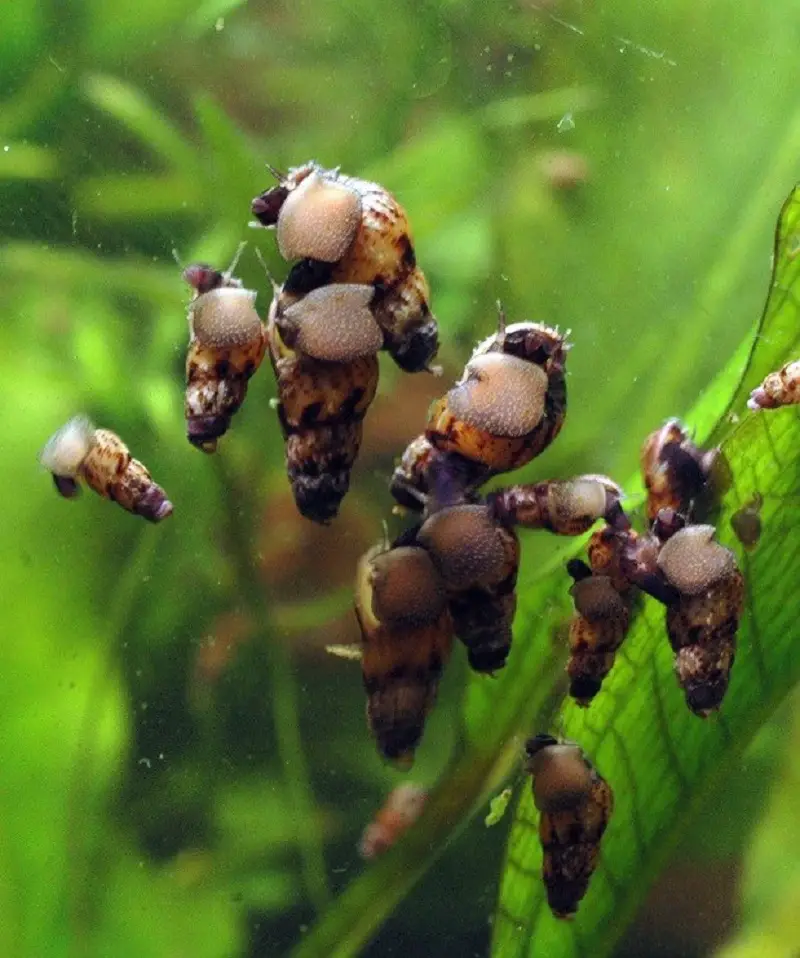
Aquarists that like Malaysian Trumpet Snails aren’t just fans because they graze algae, these snails can also look quite attractive in a tank.
This is mainly due to the shape of their shell, which is different from the usual spiraling circle shape that’s common for many species.
The shell of a Malaysian Trumpet Snail is elongated, stretching out to look like an ice cream cone. Each shell is usually composed of about 10-15 whorls.
There are a series of thin rings along with the shell. These develop as the snail (and shell) grows, making them a good indicator of how old the snail is.
At the opening of the shell is an operculum. This acts as a trapdoor for snails to seal themselves inside their shell for protection.
Though their shells are an interesting shape, they don’t boast bright colors. Most snails are pale brown or grey, but some populations are darker, potentially black.
This is the case in Israel; dark shells allow the snails to camouflage against dark basalt rocks in the Sea of Galilee.
Some Malaysian Trumpet Snails have red spots circling around with the whorls.
Their heads are flat, with a pair of tentacles at the base. These hold the eyes.
This is a very small species. Young individuals are tiny, but adults reach about an inch in length. Females tend to be slightly larger than males.
Females also have green gonads, whereas males have red gonads.
Habitat and Tank Conditions
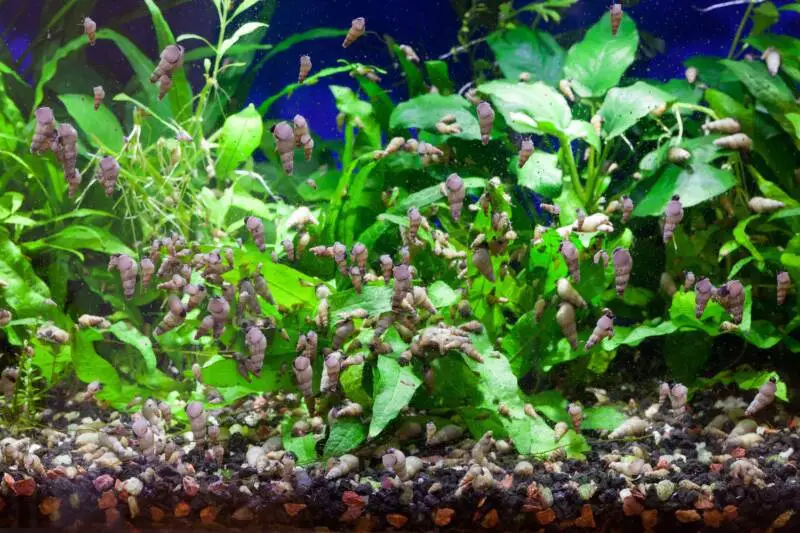
Though Malaysian Trumpet Snails originated in Northern and Southern Africa, they can now be found all around the world. They spread easily, often due to humans accidentally introducing them to new areas.
Their ability to spread comes down to their fast reproduction rate and hardy nature. This hardiness means they can tolerate a range of conditions, and therefore, live in a range of environments.
They primarily live in freshwater, though some manage to survive in brackish waters.
They thrive in habitats with poorer conditions because they can tolerate pollutants better than most other species.
Malaysian Trumpet Snails are found in slow-moving water, where oxygen levels might be slightly reduced. Below the surface would be plenty of live plants and a soft substrate for burrowing.
Temperature and pH can vary greatly between populations.
This species is happy in a broad array of conditions so it’s easy to design a suitable aquarium that replicates their natural preferences.
Tank Conditions
It is recommended that you keep Malaysian Trumpet Snails in a freshwater setup; this will give them the best chance at staying healthy.
Layer the bottom of your tank with a soft sandy substrate. This species burrows regularly and remains buried for long periods; larger grains could scratch.
Reserve areas of the aquarium for live plants. These offer shelter and food, while also helping to keep the water cleaner.
These snails will mostly limit themselves to eating dead plant matter that falls to the substrate, rather than the live plants themselves. Most plants can survive small amounts of nibbling.
You can add any decorations you want. These will provide extra surfaces for your snails to traverse in the hunt for algae.
The water should be kept at a temperature between 70°F and 80°F. The pH should be maintained at 7.0-7.5 too.
No specialized equipment is needed. This species prefers slow-moving water so an air/water pump is unnecessary, the filter outlet will be more than adequate. Standard aquarium lighting is fine too.
A strong filter inlet can damage these snails if they get too close. A sponge cover over the inlet should reduce this risk.
If the tank conditions are right, Malaysian Trumpet Snails will mostly look after themselves, without much effort from you.
What Size Aquarium do they need?
These tiny snails don’t need much space at all. Since they don’t grow bigger than an inch, a small group can live in a tank as small as 5 gallons.
Smaller tanks are harder to maintain, and extra space will always be appreciated by your snails, so the bigger your tank, the better.
How Many Can be kept per gallon?
You could keep 1-2 snails per gallon if they are the only species in the tank. Keep fewer if you have a community because you don’t want to overload your filtration system.
Tank Mates
This is a peaceful species that can fit easily into a community aquarium. They will stay out of the way of tank mates; their attention will be directed at finding food.
Tankmates that should be avoided are those that will view Malaysian Trumpet Snails as a snack. Fish that might do these include puffers, Oscars, and certain loaches.
Some invertebrates make terrible tank mates too, like Assassin Snails. These will greedily eat your Malaysian Trumpet Snails. In fact, trumpets are often used as feeders for Assassin Snails.
Some safer invertebrates include Ramshorn Snails, Mystery Snails, Bamboo Shrimp, and Ghost Shrimp.
Small fish are good choices because they won’t be big enough to eat your snails, even though they’re small too. You could try Neon Tetras, Mollies, Tiger Barbs, Corydoras Catfish, or Otocinclus.
There are lots of possibilities, but always check compatibility before buying anything for your tank.
Can You Keep Malaysian Trumpet Snails Together?
These snails will be fine in a group, they’ll ignore each other and focus on their own lives. They’re so small that keeping just one individual would be pretty pointless.
Once you have a few, they will start breeding rapidly, so don’t be surprised if your population grows. Some people have to introduce a control method to prevent their numbers from getting out of control.
Diet
A lot of a Malaysian Trumpet Snail’s life is spent looking for food because the more they eat, the more energy they have for reproduction.
They will spend the daytime buried in the substrate, coming out to feed when the light diminishes.
They’ll eat most organic matter that they come across. Usually, things that have fallen to the floor, like dead plants, dead fish, fish waste, and uneaten fish foods.
Though they enjoy eating dead plants, they should leave your live plants alone if they are finding enough food elsewhere in the tank.
Algae and microbial films make up a large portion of their diet too. These develop on all surfaces in an aquarium, snails can then go and scrape them off.
This can save you a bit of time since you’ll have to wipe away excess algae less regularly. You will lose this benefit if you keep too many snails since they’ll be producing more waste than your filter can handle.
To vary the diet of your Malaysian Trumpet Snails, you can add small pieces of green vegetables into the tank. Try using lettuce, broccoli, spinach, or cucumber.
These vegetables will introduce some calcium into the diet. Calcium is vital for a snail to develop a strong shell. Without calcium in their diet, snails will become particularly vulnerable to damage.
Care
This species will mostly look after themselves. They are tolerant of a range of conditions and much of their food develops naturally in the tank.
Though they can live in a range of conditions, a sudden change in environmental conditions can be harmful. You need to maintain a consistent internal environment.
Use a water testing kit each week to check that parameters are at the levels they should be.
You should be keeping the tank clean by performing regular water changes and wiping away excess algae. Don’t remove too much algae or there won’t be enough food for your snails.
If your snails don’t appear to be finding enough food, you can add some. You may also want to add food to control their diet, such as providing extra calcium for shell development.
If a snail doesn’t get enough food, their shell growth can become stunted, leaving them vulnerable to damage. If they eat too much, their shells grow faster and get darker.
The disease is rarely a problem for these snails. Sometimes they can pick up parasites, which present as white spots on their shells.
It is common for Malaysian Trumpet Snails to act as an intermediate host for parasites like trematodes. These can then spread to vertebrates like humans.
Transmission only happens when eating raw infected fish, so you don’t need to worry about getting ill from the snails in your tank.
When adding chemicals to your aquarium, always check that they do not contain copper. Copper is toxic to invertebrates.
Controlling Malaysian Trumpet Snails
If Malaysian Trumpet Snails have gotten into your tank accidentally, there are a few things you can do to keep their numbers low or eradicate them completely.
The most natural form of control is to introduce a predator that loves to eat small snails. Options include loaches, goldfish, and Assassin Snails.
Removing individual snails by hand is another control option, but this takes a lot of effort regularly. You won’t be able to find every single snail to eradicate them either.
The best eradication technique is to use chemicals. Fish medications containing copper will kill Malaysian Trumpet Snails, but be aware that they will harm all other invertebrates too.
Breeding
Malaysian Trumpet Snails are a live-bearing species that can reproduce in two ways: either through parthenogenesis or sexual reproduction.
Parthenogenesis (also known as virgin birth) is where females give birth to young female clones. These will be genetically identical to the parent. Males are not needed to fertilize the eggs for this to happen.
This method means that a single female can multiply to produce a whole colony, showing how easy it is for this species to establish themselves in a new area.
Sexual reproduction is where a male’s sperm is needed to fertilize a female’s eggs. This is the rarer form of reproduction in this species and tends to occur more often in populations with a large percentage of males.
A single female can produce over 200 young. The embryos develop in brood pouches before being released as juveniles with 5-6 whorls on their shell.
Not all of the embryos will develop into juveniles, many will be ingested by other embryos in the pouch.
Hatching usually occurs during the night because this is when the species is most active. The newborns will be just 0.08 inches.
Juveniles can reach sexual maturity when they’re just 0.3 inches, but their reproductive capacity peaks at 0.8 inches, before reducing again as size increases further.
Malaysian Trumpet Snails grow rapidly, about 0.1 inches a month, so it doesn’t take long for the juveniles to reach a size where they can start producing the next generation of snails.
Are Malaysian Trumpet Snails Suitable for Your Aquarium?
These snails fit well into most aquariums, so you just need to decide whether you think Malaysian Trumpet Snails are pets or pests. There is no right answer, there are both pros and cons to this species.
They make good pets because of their algae-eating services, but they can easily enter an aquarium unnoticed and multiply rapidly, which could overload your filtration system.
If you decide that you want these snails as pets, you should now feel confident about how to care for them. It doesn’t take much effort; the main consideration is ensuring that tank mates aren’t snail-eaters.
If you’re trying to get rid of these snails, we’ve outlined a few ways that you can control them.
Malaysian Trumpet Snails may be a controversial topic, but everyone is allowed their own opinion.
Are Malaysian Trumpet Snails pets or pests? Let us know your thoughts in the comments below…

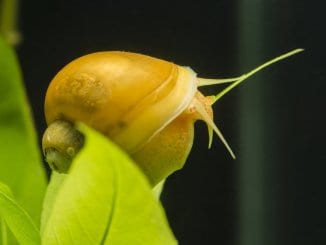
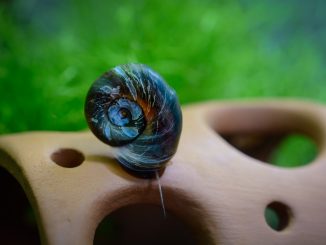
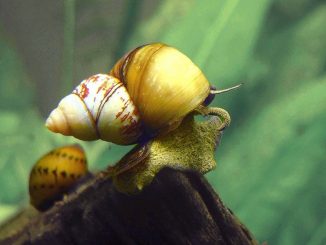
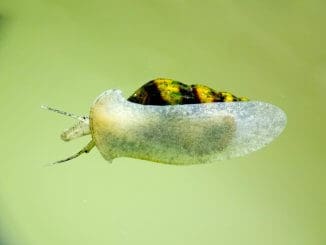

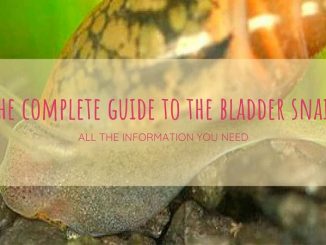
Be the first to comment